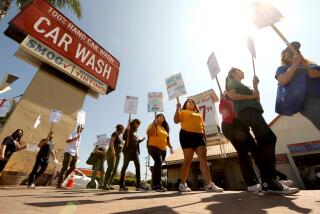Public Employees Find Strikes Pay : Militancy Contrasts With Union Declines in Private Sector
- Share via
WASHINGTON — After August of 1981, when President Reagan fired 11,400 air traffic controllers for going on strike, unions representing public employees generally pulled in their horns. No more.
Already this summer, the American Federation of State, County and Municipal Employees, the nation’s largest public employees union, has struck in two major cities--Philadelphia and Detroit--producing frayed nerves, mounds of rotting garbage and the prospect of significant salary increases for the striking workers.
And if acrimonious strikes represent a shift from the union’s low profile, they are downright revolutionary contrasted with the tactics of most unions representing America’s hard-pressed heavy industries, such as steel and automobile manufacturing.
Resurgence or Last Gasp?
The AFSCME’s aggressiveness could represent the beginning of a resurgence of union activism--or the last gasp of America’s declining organized labor movement.
“For the time being,” said Sar Levitan, director of the Center for Social Policy Studies at George Washington University, “AFSCME is quite militant and willing to go out and strike.” But the union’s fortunes are intimately tied to the financial health of cities and states, he said.
AFSCME President Gerald McEntee said in an interview: “In order to have strength and service your members, you have to have some numbers.”
And the AFSCME and other public employee unions increasingly have the numbers. According to the Labor Department, private sector workers who belong to unions fell from 14.3 million in 1980 to 11.2 million last year--just 14.6% of all workers in private industry. During the same period, public employee unions held even at 5.7 million members--almost 36% of the work force in federal, state and local governments.
Fastest-Growing Union
The AFSCME has become the nation’s fastest-growing union by attracting a growing share of public union members, largely through mergers and affiliations. It now represents 1.1 million workers, almost entirely in state and local government, ranging from such blue-collar workers as trash collectors to a host of others, including clerks, librarians, chemists and architects.
Contributing to the AFSCME’s recent militancy is the gradually improving financial health of the cities and states where its members work. For a period, McEntee said, the AFSCME refrained from major wage and benefit demands because it knew the employers could not afford them. But now, he said, “we’d like something reasonable for the sacrifice we’ve made.”
Beyond that, labor economists point out that public employees, unlike many of their counterparts in the private sector, do not have to worry that their products can be replaced by imports. As Rutgers University professor Leo Troy put it: “You don’t have competition from Japan when you’re collecting garbage.”
Number of Strikes Plummets
Experts say public employees are almost surely responsible for an increasing share of the nation’s strikes, although the Labor Department, thanks to a Reagan Administration budget cut, has quit collecting the data with which they could prove their case. Altogether, the number of strikes at work sites with more than 1,000 employees has plummeted from 235 in 1975 to 54 last year, the lowest since World War II.
Regardless of whether they strike more often, public employees have clearly outstripped their private counterparts in recent wage and benefit settlements.
Workers in the private sector won average wage increases of 3.5% a year from major collective bargaining contracts in 1985, and the figure is dropping this year, according to the Labor Department. About 15% of private workers settled for either no increase or decreases averaging 6.6% a year.
State and local government workers, meanwhile, received annual raises averaging 5.4% in 1985 settlements, and none settled for decreases.
Big Gains in Two Cities
In Philadelphia, 13,000 AFSCME members ended their three-week strike on July 21 by accepting Mayor W. Wilson Goode’s offer of a 10% increase over two years. In Detroit, 7,000 trash collectors, bus drivers and clerks and others have pushed Mayor Coleman Young into offering at least 7.5% over three years, and more if the city’s financial health improves. The mayor is also offering a one-time bonus of $500 per worker.
Private employee unions, by contrast, frequently strike to protect benefits their employers are threatening to withdraw. Wayne Vroman, senior research associate at the Washington-based Urban Institute, said that at a time when steel workers are giving back salary and benefits just to keep their jobs, “anything more than zero is an accomplishment.”
When 155,000 telephone operators, technicians, clerks and sales and factory workers in the Communications Workers of America struck American Telephone & Telegraph Co. for 26 days in June, they managed to win an 8% wage increase over three years. Union spokesman Rozanne Weissman said the CWA is “one of the few unions to have made gains” in recent years. But the company succeeded in eliminating the CWA’s prized cost-of-living adjustments during the life of the new contract.
Increases in Other Cities
The AFSCME has 3,000 contracts with governmental units in 46 states, including most of the nation’s biggest cities. Most of the contracts expire on June 30, but not all in the same year. This year, in addition to Philadelphia and Detroit, major cities with expiring contracts were Baltimore, Minneapolis, Phoenix, San Diego, San Jose and Tulsa.
Minneapolis remains without a contract, and only Tulsa employees settled for no raise, AFSCME officials said. Elsewhere, wage increases ranged from 4.5% over two years in Phoenix to 12% over three years in San Jose, where 1,000 employees also received adjustments to provide equal pay for comparable work. Such adjustments are a hallmark of AFSCME negotiations because the union represents many workers in traditionally underpaid positions filled by women.
In Los Angeles, Harriet Newton, president of the Librarians’ Guild, AFSCME Local 2626, said that last year’s agreement with the city netted her and 400 other city librarians increases of $6,000 over two years because the union convinced the city that the librarians were underpaid when their salaries were compared to administrative assistants--workers whose jobs were deemed comparable in worth.
‘Nobody Likes a Strike’
McEntee, the union’s president, said the AFSCME is not looking for strikes. “Nobody likes a strike,” he said. “Employees lose money, and in most cases they are never able to make it up. The threat of a walkout is what hopefully brings a measure of equality to the (bargaining) table.”
Trying to capitalize on their current momentum, the AFSCME leaders are seeking ways to expand their rolls even more. The union has launched aggressive advertising campaigns touting its successes. And McEntee said his organization, one of 98 affiliated with the AFL-CIO, is planning to do “more joint organizing” with other AFL-CIO unions.
Previously, said McEntee, unions had wasted resources trying to organize the same workers within one workplace. “Rather than acting like the Lone Ranger, the unions are coming together,” he said.
More to Read
Sign up for Essential California
The most important California stories and recommendations in your inbox every morning.
You may occasionally receive promotional content from the Los Angeles Times.










